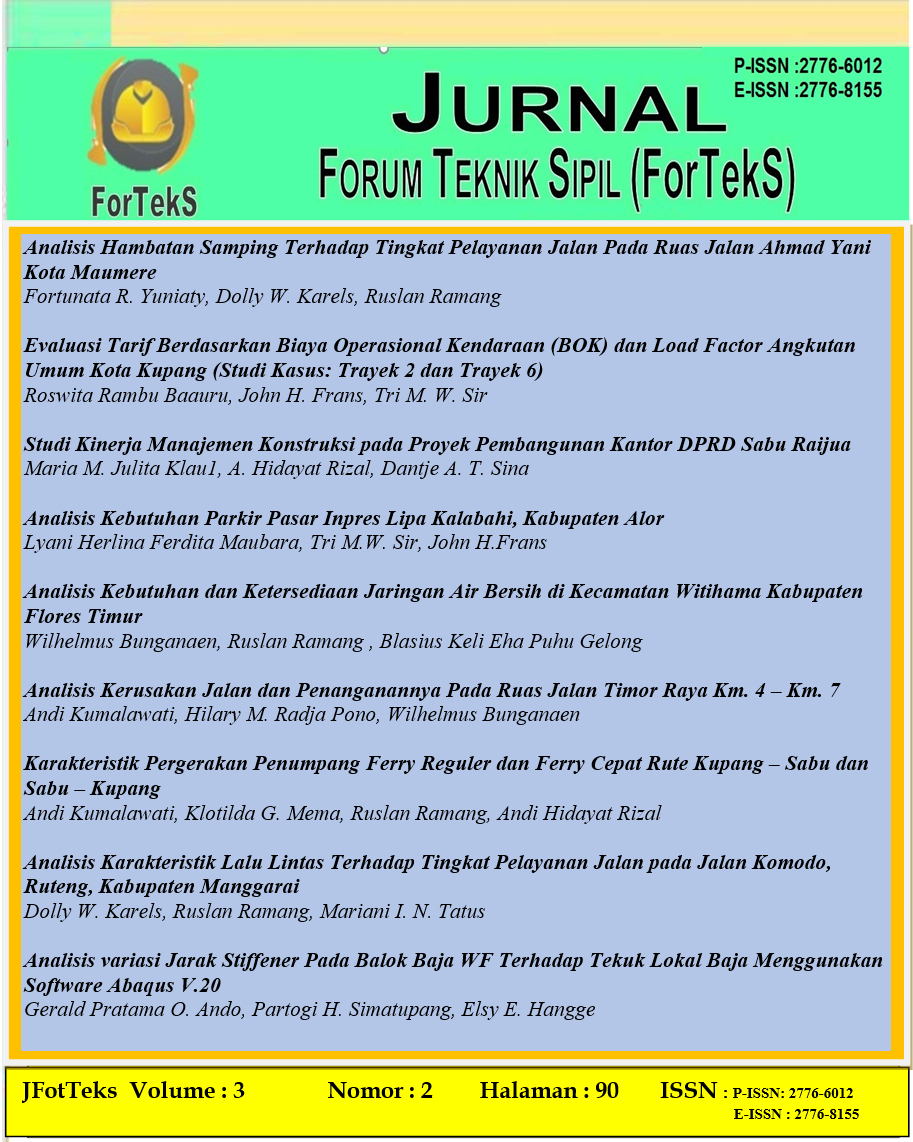Analisis Kerusakan Jalan dan Penanganannya Pada Ruas Jalan Timor Raya Km. 4 – Km. 7
Road Damage Analysis and Handling on the Timor Raya Km. 4 – Km. 7
Abstract
The existence of highways is very necessary to support the pace of economic growth, agriculture, and other sectors. Given the important benefits, it is for this reason that the road construction and maintenance sector is a priority to be researched and developed in implementation planning, as well as maintenance. The purpose of this study was to determine the value of the Pavement Condition Index (PCI), identify the factors causing damage to Jalan Raya Timor Km.4-Km.7 and find out the type of repair according to the type and level of damage to Jalan Raya Timor Km.4 - Km.7. The average PCI value for Jalan Timor Raya Km.4 - Km.7 was 59.67 and there were 6 types of damage that occurred on Jalan Timor Raya Km.4 - Km.7, Oesapa Village, Kupang City, namely grain release, holes, crocodile skin cracks, bleeding, corrugation and collapse. The percentage of damage that occurs according to the type of damage is Grain Release 17.29%, Collapse 40.61%, Bleeding 31.72%, Crocodile Skin Cracks 2.44%, Holes. Factors causing damage to Jalan Timor Raya Km.4 – Km.7 include: Excessive vehicle loads so that the strength of the bottom structure of the road pavement or the road pavement structure itself is not able to carry it, poor compaction implementation, uneven or excessive use of asphalt and traffic that clears before the pavement is firmly used.
Downloads
References
Batua, Panji Akbar heman, dan Rosyad Farlin. 2019. “Analisis Kerusakan Jalan dengan Metode Pci ( Pavent Condition Index ) Pada Ruas Jalan Betung -Sekayu Km 77 - Km 82.” In Bina Darma Conference Engineering Sains, , 244–54.
http://conference.binadarma.ac.id/index.php/BDCES.
Hardiyatmo, Hary Christady. 2007. “Pemeliharaan Jalan Raya, Edisi Pertama.” Gadja Mada Universitisy Press. Yogyakarta.
Hendarsin, Shirley L. 2000. “Perencanaan Teknik Jalan Raya.” Politeknik Negeri Bandung.
Nugroho, Eko Agus. 2013. Pengaruh Jumlah Kendaraan Terhadap Kerusakan Jalan Aspal Kelas II di Kabupaten Semarang.
Prasetiawan, Jauhari, dan Husnul Khotimah. 2021. “Analisa kerusakan jalan dengan metode pavement condition index (PCI) dan alternatif penyelesaiannya (studi kasus: jalan AA Gde Ngurah kota Mataram).” Jurnal Handasah: 24–29.
Shahin, M Y. 1994. “Pavement Condition Survey and Rating Procedure.” In Pavement Management for Airports, Roads, and Parking Lots, Springer, 15–38.
Sulaksono. 2001. Departemen Teknik Sipil, Penerbit ITB, Bandung Rekayasa jalan.
UU RI No. 22 Tahun 2009. 2009. Undang-undang Republik Indonesia nomor 22 tahun 2009 tentang lalu lintas dan angkutan jalan. Eko Jaya.
Zaid, Muhammad, Rahayu Sulistyorini, dan Siti Anugrah Mulya Putri Ofrial. 2021. “Analisis Tingkat Kerusakan Jalan dengan Menggunakan Metode Pavement Condition Index (PCI) (Studi Kasus Jalan P. Tirtayasa Bandar Lampung).” Jrsdd 9(2): 201–12.
Copyright (c) 2023 JURNAL FORUM TEKNIK SIPIL (J-ForTekS)

This work is licensed under a Creative Commons Attribution-ShareAlike 4.0 International License.
Jurnal ForTeks memberikan akses terbuka terhadap siapapun agar informasi dan temuan pada artikel tersebut bermanfaat bagi semua orang. Semua artikel jurnal ini dapat diakses dan diunduh secara gratis, tanpa dipungut biaya sesuai dengan lincense creative comons yang digunakan
ForTeks : Jurnal Forum Komunikasi Teknik Sipil is licensed under a Creative Commons Attribution-ShareAlike 4.0 International License

 Andi Kumalawati(1*)
Andi Kumalawati(1*)

















